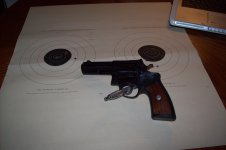TheWanderingRed
New member
Hey you guys, I’m new to shooting, and I’m relatively poor, being a struggling car salesman. I’ve owned my Ruger GP100 for a little over a year, and I’ve only had the time/money to take it out to the range three or four times  . Sales have picked up and I’m looking to spend some time with it on my off day this Friday, and I was wondering, what can a new shooter do to utilize his time at the range most effectively? I’ll be using some Winchester .38 special target ammo (jacketed semi-wadcutter) and I may try and pick up some Cor-Bon .38 Special+P 125 grain JHP that I’ll use for home defense, as the Ruger is primarily a bedside gun.
. Sales have picked up and I’m looking to spend some time with it on my off day this Friday, and I was wondering, what can a new shooter do to utilize his time at the range most effectively? I’ll be using some Winchester .38 special target ammo (jacketed semi-wadcutter) and I may try and pick up some Cor-Bon .38 Special+P 125 grain JHP that I’ll use for home defense, as the Ruger is primarily a bedside gun.
Thanks in advance, I’ve searched the forums already looking for advice, but have come up with nothing. Being stuck on my work computer I’m also limited as to what websites I can access.
I know some things to work on, like stance, grip, and sight picture, but I have no real effective exercises to drill these things/track my progress.
So, what type of exercises should I use?
How many rounds to a target to effectively track my progress?
Are some target’s more effective for training than others?
How many rounds should I shoot of range ammo vs defensive ammo to ensure that I’ll be prepared in a defensive situation?
Thanks in advance, I’ve searched the forums already looking for advice, but have come up with nothing. Being stuck on my work computer I’m also limited as to what websites I can access.
I know some things to work on, like stance, grip, and sight picture, but I have no real effective exercises to drill these things/track my progress.
So, what type of exercises should I use?
How many rounds to a target to effectively track my progress?
Are some target’s more effective for training than others?
How many rounds should I shoot of range ammo vs defensive ammo to ensure that I’ll be prepared in a defensive situation?

